You can effectively repel ten major garden pests using mint’s natural aromatic compounds. Mint deters mosquitoes, flies, and flying insects through menthol’s pesticide properties. It disrupts ant pheromone trails, repels spiders and spider mites, and confuses aphids targeting your crops. The strong aroma also keeps away mice, fleas, and biting insects when you plant strategically around problem areas. Crushing fresh leaves releases concentrated oils for immediate protection, and proper placement creates protective barriers throughout your garden space.
Mosquitoes and Flying Insects
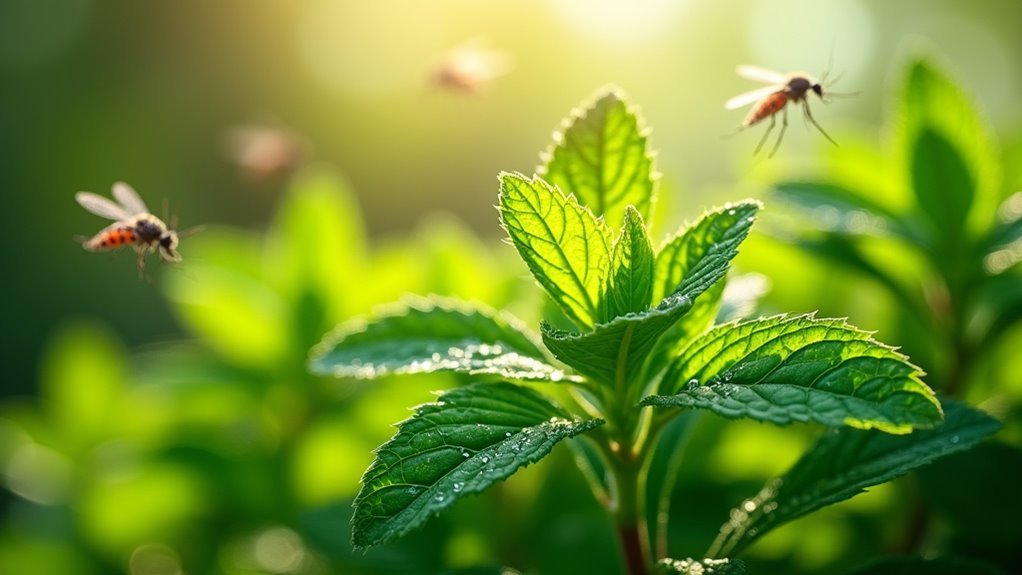
When you’re battling mosquitoes and other flying pests in your garden, mint becomes one of your most powerful natural allies. Peppermint and spearmint varieties emit strong aromas that effectively repel insects, disrupting their ability to locate you as their host.
Mint’s powerful aromatic compounds create an effective natural barrier against mosquitoes and flying pests in garden spaces.
The menthol in mint acts as a natural pesticide, deterring mosquito larvae and reducing their overall presence in your garden areas.
You’ll maximize mint’s effectiveness by crushing the leaves to release concentrated oils, creating an immediate protective barrier.
Plant mint strategically around outdoor seating areas and pathways to keep bugs away from spaces where you spend time. This natural approach greatly decreases mosquito activity, allowing you to enjoy your garden without constant pest interference.
Ants and Crawling Pests
You’ll find mint particularly effective against ants and other crawling pests that threaten your garden’s health.
The plant’s strong menthol compounds disrupt the pheromone trails ants use for navigation, fundamentally breaking their communication system and preventing them from locating food sources.
Mint’s Ant Deterrent Properties
Although ants play beneficial roles in many ecosystems, they can quickly become unwelcome guests when they invade your garden beds and damage your prized plants.
Fortunately, mint serves as an excellent natural insect repellent against these persistent pests. The strong aroma from spearmint and peppermint varieties creates an effective barrier that ants actively avoid.
The secret lies in mint’s menthol compound, which masks attractive scents and disrupts the pheromone trails ants use for navigation. When you plant mint strategically around ant-prone areas, you’ll establish a protective zone that keeps them away from valuable crops.
Mint’s invasive growth habit works to your advantage here, creating dense ground cover that crawling pests find difficult to traverse. You can boost effectiveness by crushing fresh leaves or applying mint essential oil directly to problem areas.
Protecting Against Ground Insects
Beyond ants, mint’s protective qualities extend to numerous other crawling insects that threaten your garden’s health. The menthol in mint acts as a natural pesticide, creating an effective barrier against beetles, aphids, and various ground-dwelling pests that damage plant roots and stems.
When you plant mint strategically around garden beds, you’ll repel these unwanted visitors while maintaining an organic approach to pest control.
Crushing mint leaves releases potent oils that intensify the repellent effects, making your garden even less appealing to crawling insects.
However, mint’s invasive nature requires careful management. You’ll want to contain it in pots rather than allowing free growth, ensuring you maintain effective pest control without letting mint overtake your entire garden space.
Spiders and Arachnids
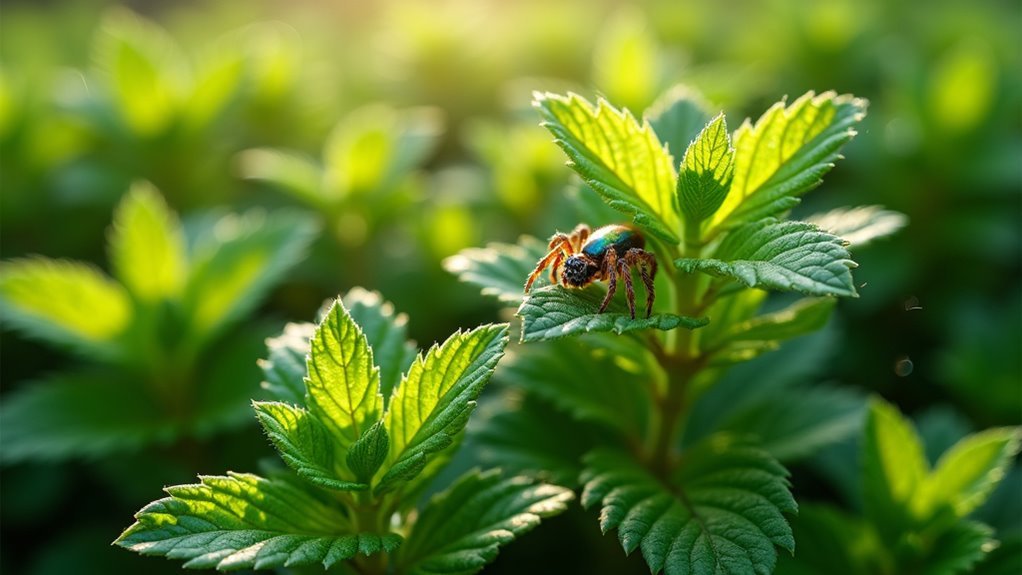
While spiders play beneficial roles in controlling other garden pests, many gardeners prefer to keep these eight-legged visitors at bay, and mint offers an effective natural solution.
Peppermint and spearmint’s strong aroma naturally repels various spider species, creating an unwelcome environment for them. The menthol in mint acts as a natural pesticide that deters spiders, spider mites, and other arachnids that might damage your plants.
You can strategically plant mint near entryways and garden paths to create protective barriers. For enhanced protection, rub fresh mint leaves on surfaces or apply mint essential oil around problem areas.
However, you’ll want to keep away from planting mint directly in garden beds—contain it in pots to prevent invasive growth that could disrupt your garden’s plant diversity.
Aphids and Plant-Sucking Insects
Aphids rank among the most destructive pests in any garden, but mint’s powerful aromatic compounds provide an effective natural defense against these plant-sucking invaders.
When you plant peppermint or spearmint near susceptible crops, you’re creating a protective barrier that confuses and deters aphids from locating their preferred food sources.
Mint’s strong scent masks the appealing aromas that typically attract these destructive insects to your plants.
The menthol compounds in mint don’t just repel aphids – they actually disrupt their feeding and reproductive cycles, reducing overall populations in your garden.
As a natural pest deterrent, mint offers you an eco-friendly alternative to chemical pesticides while enhancing your garden’s health and productivity through its proven insecticidal properties.
Mice and Small Rodents
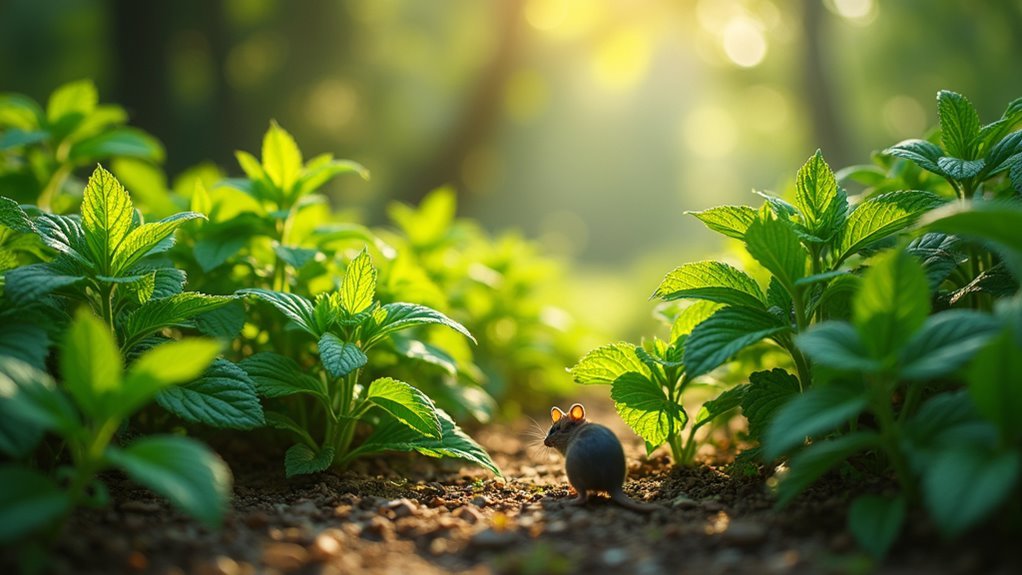
You’ll find that mint’s strong aroma acts as a powerful natural deterrent against mice and small rodents who rely heavily on their sense of smell for navigation.
Strategic placement of mint plants around your garden’s perimeter and near potential entry points creates an effective barrier that masks other plant scents these pests seek out.
Whether you’re using fresh mint leaves crushed at access points or dried mint scattered in problem areas, both forms maintain their repelling properties to keep rodents away from your garden.
Mint’s Natural Repelling Properties
When mice and other small rodents catch a whiff of mint’s potent aroma, they’ll typically retreat and seek shelter elsewhere. This powerful scent works by overwhelming their sensitive noses and masking other attractive odors in your garden.
You can maximize mint’s effectiveness by rubbing fresh leaves directly on surfaces around your garden beds and entry points to structures.
Planting mint strategically creates natural barriers that discourage rodent activity, though you should consider container gardening to prevent its aggressive spreading.
The strong essential oils in peppermint and spearmint varieties provide the most potent deterrent effects. While mint effectively repels mice and small rodents, it also helps control various insect pests, making it a versatile addition to your natural pest management strategy.
Strategic Placement Around Gardens
Since mint’s effectiveness depends largely on proper positioning, you’ll want to focus on creating protective zones around your garden’s most vulnerable areas. Plant mint containers along your garden’s perimeter to establish a scent barrier that deters mice and small rodents. The menthol aroma creates an unwelcoming environment for these pests while helping keep insects away too.
| Location | Container Strategy | Maintenance |
|---|---|---|
| Garden borders | Space containers 6-8 feet apart | Brush leaves weekly |
| Entry points | Double container placement | Replace every season |
| Vulnerable crops | Surround high-value plants | Crush leaves regularly |
Position containers rather than direct planting to control mint’s invasive growth. Focus on corners, gates, and areas where you’ve noticed rodent activity. Regular interaction with the plants releases stronger aromas, maximizing their protective benefits.
Fresh Vs Dried Effectiveness
Fresh mint leaves pack considerably more pest-deterring power than their dried counterparts when you’re targeting mice and small rodents.
The key difference lies in the aromatic oils that make mint so effective against these pests.
When you use fresh mint, you’re harnessing the full strength of volatile oils that mice find overwhelming.
Dried mint loses much of its potency during the drying process, making it less reliable for rodent control.
Here’s how to maximize mint’s effectiveness:
- Crush or bruise fresh leaves to release more aromatic oils
- Replace fresh mint regularly to maintain strong scent levels
- Focus fresh mint placement in areas with noted rodent activity
The potent aroma of fresh mint masks food odors that typically attract mice, while dried versions simply can’t compete with this level of deterrent power.
Cabbage Moths and Garden Moths
Although cabbage moths pose a significant threat to brassica crops, mint’s potent aromatic compounds create an effective natural deterrent against these persistent garden pests.
When you plant peppermint or spearmint near your cabbages, the strong aroma masks your host plants’ scents, making it difficult for moths to locate their preferred vegetation. You’ll create a protective barrier that reduces infestation likelihood and subsequent crop damage.
Mint’s volatile oils become particularly effective when leaves are crushed or brushed against, releasing compounds that deter moths and other pests.
Fleas and Biting Insects
You’ll find mint’s natural repellent properties work exceptionally well against fleas and biting insects that plague both your garden and outdoor spaces.
Spearmint and peppermint varieties contain the highest concentrations of menthol, making them your most effective options for pest control.
You can apply mint’s protective benefits by rubbing fresh leaves directly on your skin, planting it strategically around your garden, or creating natural sprays from the essential oils.
Mint’s Natural Repellent Properties
When you’re battling pesky fleas and biting insects around your home, mint’s powerful aromatic compounds work as nature’s own pest control system. The menthol in peppermint and spearmint disrupts insects’ sensory receptors, making your space less appealing to these unwanted visitors.
Mint’s natural repellent properties stem from potent essential oil compounds that create an invisible barrier against pests. You can harness this power through several methods:
- Rub fresh mint leaves directly on your skin for immediate protection
- Plant pennyroyal mint around pet areas to deter ticks and fleas
- Use peppermint essential oil in homemade sprays for targeted application
Commercial repellents have recognized mint’s effectiveness, incorporating peppermint oil into their formulations. This validates centuries of traditional pest control methods using mint concoctions.
Effective Mint Varieties
Since different mint varieties contain varying concentrations of essential oils, choosing the right type can greatly boost your pest control success.
Peppermint and spearmint stand out as the most effective mint varieties for your garden pest control needs. Their potent aroma and high menthol content make them particularly powerful against fleas, mosquitoes, and other biting insects.
For tick and flea problems specifically, you’ll want to take into account pennyroyal mint. This specialized variety targets these stubborn pests effectively, making it invaluable for thorough garden protection.
These effective mint varieties work by masking the scents that typically attract insects to your space.
To maximize their ability to repel insects, crush the leaves or brew them into sprays, which releases more aromatic oils for stronger deterrent effects.
Application Methods for Protection
Although mint’s natural pest-repelling properties are well-established, applying it correctly makes all the difference in protecting yourself from fleas and biting insects.
These proven application methods will help you effectively repel unwanted pests:
- Fresh leaf application: Rub fresh peppermint or spearmint leaves directly on your skin. The crushed leaves release concentrated aromatic compounds that disrupt insects’ sensory receptors, creating an immediate protective barrier.
- DIY spray solution: Mix peppermint or spearmint oil with witch hazel to create a natural repellent spray. Apply this mixture to your skin and clothing for extended protection against mosquitoes, fleas, and other biting insects.
- Garden planting: Strategically plant mint throughout your garden areas. The high menthol content acts as a natural pesticide, reducing mosquito larvae populations while attracting beneficial insects for thorough pest management.
Flies and House Pests
While most people think of flies as merely annoying buzzing nuisances, these persistent pests can quickly turn your peaceful garden retreat into an uncomfortable experience. Mint’s powerful aroma serves as an effective natural deterrent against flies and various house pests that threaten your outdoor sanctuary.
The menthol in spearmint and peppermint acts as nature’s pesticide, creating an aromatic barrier that keeps insects away from your garden space. You can rub fresh mint leaves directly on your skin to mask scents that attract flies.
For broader protection, create DIY repellent sprays by mixing peppermint oil with witch hazel. Strategic mint placement around your garden’s perimeter effectively blocks flies from entering your home, while simultaneously deterring spiders and other unwanted insects naturally.
Spider Mites and Microscopic Pests
When spider mites invade your garden, these microscopic vampires silently drain the life from your plants by puncturing leaves and sucking out essential nutrients.
You’ll notice yellowing, stippled leaves that eventually turn bronze and drop off. Fortunately, mint offers a powerful defense against these destructive pests.
The strong menthol aroma from spearmint and peppermint varieties masks the scents that attract spider mites to your plants.
Studies demonstrate that mint’s presence notably reduces spider mite populations in surrounding areas.
Beyond spider mites, mint also repels:
- Aphids that cluster on stems and leaves
- Whiteflies that damage plant health
- Other microscopic pests targeting your garden
Plant mint strategically around vulnerable crops to create a protective barrier while attracting beneficial insects that naturally prey on these harmful pests.
Fungus Gnats and Soil-Dwelling Insects
Fungus gnats present a different challenge from airborne pests, as these tiny black flies emerge from moist soil where their larvae feed on organic matter and plant roots.
Mint’s powerful aroma, particularly from peppermint and spearmint varieties, effectively repels these troublesome insects. The menthol in mint disrupts their life cycle, preventing soil-dwelling insects from establishing colonies in your garden beds.
You’ll find that planting mint around vulnerable areas creates a natural protective barrier.
Position mint in pots or directly in garden soil to reduce fungus gnat populations. Regularly crushing mint leaves releases essential oils that strengthen its pest-repelling qualities.
This simple technique enhances mint’s effectiveness against soil-dwelling insects while protecting your more delicate plants from root damage caused by larvae feeding beneath the surface.
Frequently Asked Questions
What Pests Does Mint Repel?
You’ll find mint repels mosquitoes, flies, spiders, aphids, and flea beetles effectively. Pennyroyal mint specifically deters ticks and fleas. Crushing mint leaves releases essential oils that enhance its natural pest-repelling properties in your garden.
What Mint Is Best for Pest Control?
You’ll find peppermint works best for overall pest control since it repels mosquitoes, flies, and spiders effectively. However, spearmint’s also excellent for targeting ants, moths, and rodents in your garden spaces.
What Does Mint Protect Against?
You’ll find mint protects against mosquitoes, flies, spiders, white cabbage moths, ants, and flea beetles. It may also deter larger pests like rabbits and deer, offering natural, eco-friendly protection for your garden.
What Does Mint Attract?
You’ll attract beneficial hoverflies, predatory insects, butterflies, and essential pollinators like bees when you plant mint. Catnip varieties can draw cats that’ll help control rodent populations in your garden area.
In Summary
You’ll find mint’s your secret weapon against garden pests without relying on harsh chemicals. Plant it strategically around your garden’s perimeter, crush leaves to release oils, or create mint-infused sprays for maximum effectiveness. Remember that mint spreads aggressively, so you’ll want to contain it in pots or designated areas. With proper placement and maintenance, you’ll naturally repel these ten common pests while enjoying fresh mint for cooking and teas.

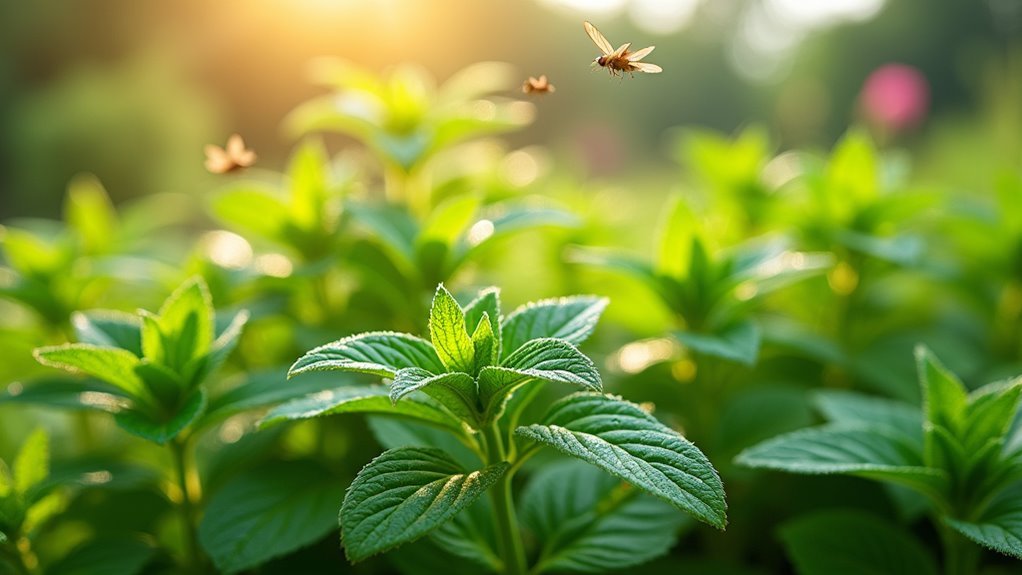
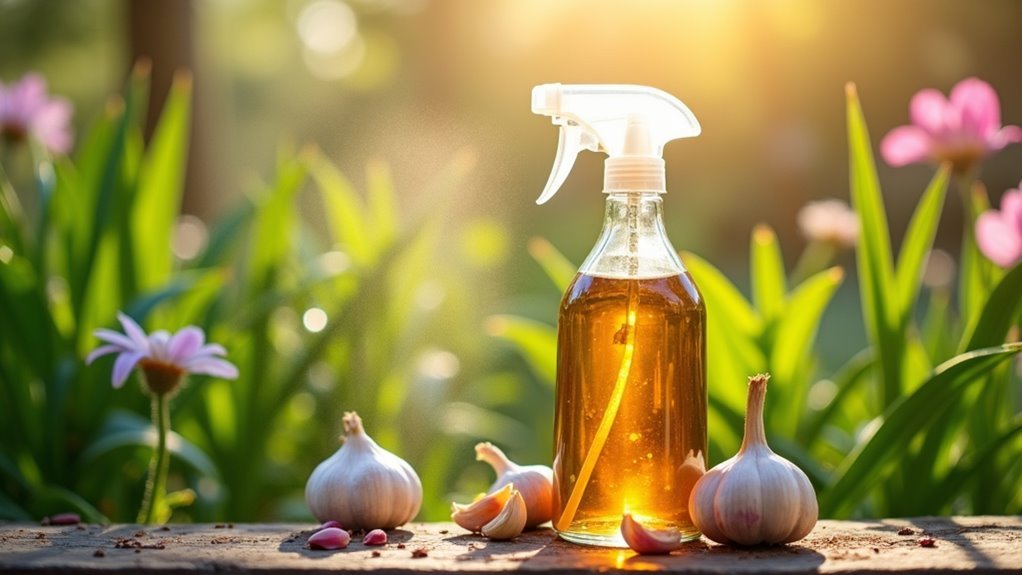

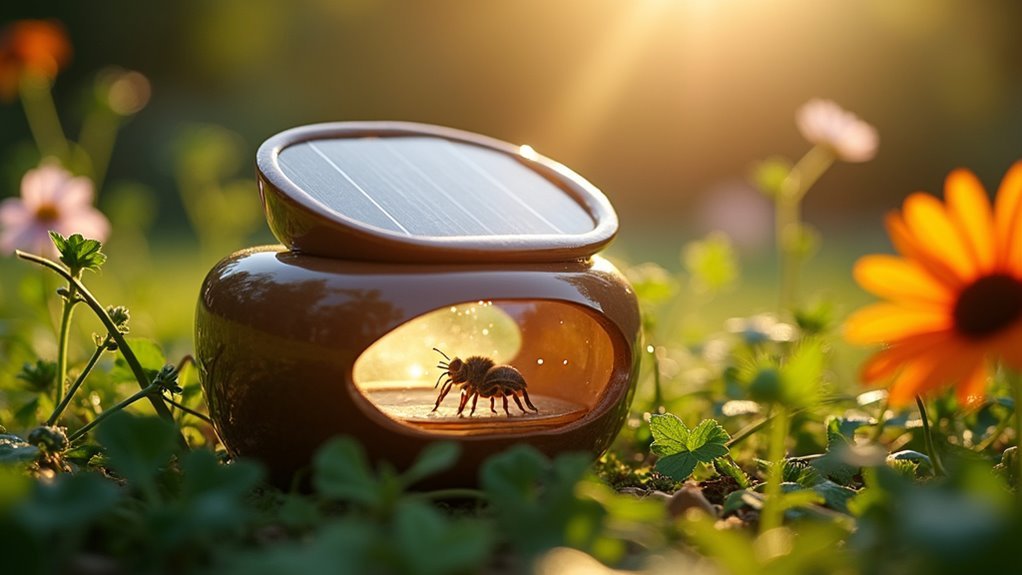
Leave a Reply